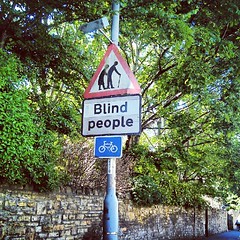Tools for Teaching Accessiblity?
July 8, 2015
 So I’ve been considering some of the issues that have been raised at the 2015 Summer Seminar: Access/ibility in Digital Publishing, trying to figure out where I fit in. I have some experience with many different kinds of issues, but I haven’t completely figured out where I belong in the conversations the group has been having.
So I’ve been considering some of the issues that have been raised at the 2015 Summer Seminar: Access/ibility in Digital Publishing, trying to figure out where I fit in. I have some experience with many different kinds of issues, but I haven’t completely figured out where I belong in the conversations the group has been having.
So I began thinking about how many students (and probably many authors) respond to concerns about making their work accessible. There’s push back, reluctance, and sometimes even refusal. It’s more than simply not wanting to do the extra work or not knowing how to do what’s necessary. I think it’s a failure to understand, even to recognize their privilege–and as a result, an inability to know what needs to change to make a project more accessible.
An example might help. Let’s say a writer adds a photo to something. She might understand that she should include an alt tag for that image, but does she understand how to write a rhetorically effective alt tag? Does she know about long descriptions? Has she ever interacted with a reader with low or no vision? How do you teach someone not to see so that she can understand the needs of her readers?
As I tried to puzzle out this complicated task of extending accessibility of a project (and we are talking about extending. These projects are already accessible. They are just not accessible to everyone or in every way possible), so as I was trying to puzzle out making a project accessible, I began wondering about the opposite (so to speak) of the task. Would I ever ask a person with low or no vision to make a project more visual by adding color, illustrations, and design elements? If I did, what kind of support would I need to provide her? How would I help her understand visual aspects that she (possibly) had never seen and might never use as she herself accessed a text? How would she know if she was meeting her goals?
A sighted writer who has never consciously worked to make a project accessible to someone with low or no vision likely feels she’s confronting similar constraints. She cannot see the absences in the project that she needs to fill out, and she doesn’t understand the extent to which she needs to fill them out. Her privileges as a sighted writer is not obvious to her.
So my question, or perhaps the challenge I’d love to address, is how do I find ways to help those who do not need alternate accessibility paths understand the task of adding them to a text? What tools are available to help such a writer understand the accessibility needs? I’m not looking for the tools to add accessibility, but teaching tools and strategies to help people understand why those accessibility tools are necessary and how they add layers of access to the project. What tools can help her understand the difference between simplistically making something accessible and making it deeply accessible?
I think there are some obvious strategies that people use, like trying to read a text with a screen reader and working to notice what is missing and what doesn’t work. There are accessibility checkers online that people can apply to their texts. I’m not satisfied that tools like these are the best solution. I’m not sure what is.